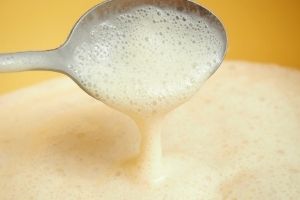The Yeast and Sugar Slurry
Ryan Monkman of FieldBird Cider in Ontario continue on with helping Ria get ready to bottle cider that has been conditioning for over 2 years! In this episode we discuss the amount of sugar to add, what kind of yeast to use and how to make what is known as a “slurry”.

But let’s first take a couple steps back….to episode 270 where Ryan offered tips for finding out if there is any sugar left in the cider. Knowing if there is any residual sugar even after 24 months is critical, especially if at the time of bottling you plan on adding a bit of what is known as “priming sugar” and yeast to create bubbles for an end product that is sparkling.
After all, “bubbles help aromas pop” says Ryan and I certainly enjoy a bit of bubbles too in the glass.
If the maker overlooks this step and adds too much sugar, the bottles will potentially over pressurize and may explode! No one in their good mind wants to make what is known as a bottle bomb, as they are very dangerous and will make all your beloved cider undrinkable as it drips down upon the wall or the floor. What a mess!
Making the slurry
- Begin with a 1/4 cup of warm water (not so hot that it would burn your finger)
- You can substitute cider for water, but make sure not to heat the cider so that it taste burnt or else that burnt flavor will transfer into the cider you are wanting to bottle.
- Use 1 yeast that works in difficult conditions such at AB-1 from Fermentis
- Bayanus yeast are used the most for making the slurry as they are able to work in very difficult conditions.
- Calculating the amount of sugar needed:
- As a rule: brewers add 3 to 4 grams of sugar/liter. So if you like how beers are usually carbonated, you can follow the same principle and add around 3-4 grams/liter.
- For 5 US gallons of cider that would mean adding around 76 grams of sugar.
- 5 gallons = 18.9271 liters | 18.9271 liters x 4 grams = 75
- Add 75 grams of priming sugar
- BUT only if you are completely sure that all the existing sugar has been fermented.
- IF your residual sugar test via clinitabs/AIM Tabs or the Fermentest show that you still have 2 grams/liter in your cider then you will subtract that amount from the total.
to Review –
- 5 gallons = 18.9271 liters
- 2 (grams) x 18.9271 = 3.78542 grams
- …I’d round 3.78542 up to 4 grams, thereby calcualting that there is 4 grams of sugar currently in my 5 gallon batch of cider. Soooo, instead of adding 75 grams, as I usually would for cider that has no residual sugar left, I will subtract 3 grams and only add 72 grams of sugar.
Mix the yeast, water and sugar for the Slurry
- Mix the warm water, yeast and sugar. Let is sit for 20 to 40 minutes so the yeast is able to reproduce more yeast cells.
- Slowly add the cider into the Slurry so that it can fully inoculate the cider – Ryan says this alone can take up to 45 minutes. For commercial makers this could be a 12 hour process!
- Once done – bottle immediately. Carbonation should begin within two weeks.
Contact for Ryan Monkman at FieldBird Cider
- website: https://www.fieldbird.ca/
- Instagram
- FieldBird https://www.instagram.com/fieldbird.cider/
- Ryan Monkman https://www.instagram.com/rgmonkman/
- Listen to past episodes with Ryan Monkman
Mentions in this Chat
- Totally Cider Tours – Reserve your seat for 2022 tour contact mailto:info@ciderchat.com
- May 14th New Salem Cider Blossom Time weekend offering – https://www.newsalemcider.com/
- Fermentis by Lesaffre –
- Q&A #19 When is the yeast most stressed during fermentation?
- Two upcoming Fermentis seminars
- May 20th – Session 1 for craft and industrial:https://www.edudip.com/en/webinar/exploring-the-diversity-of-yeast-strains-and-fermentation-conditions-for-different-cider-styles-session-1/1135676May 27th – Session 2 for home cider makers:https://www.edudip.com/en/webinar/exploring-the-diversity-of-yeast-strains-and-fermentation-conditions-for-different-cider-styles-session-2/1135696
Help Support Cider Chat Please donate today. Help keep the chat thriving!
Find this episode and all episodes at the page for Cider Chat’s podcasts.
- Listen also at iTunes, Google Play, Stitcher (for Android), iHeartRadio , Spotify and wherever you love to listen to podcasts.
- Follow on Cider Chat’s blog, social media and podcast
- Twitter @ciderchat
- Instagram: @ciderchatciderville
- Cider Chat FaceBook Page
- Cider Chat YouTube
Haven’t downloaded this episode yet? Here it is again for your listening pleasure.



